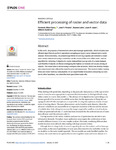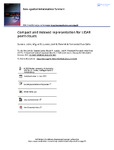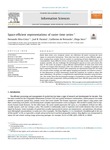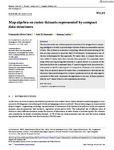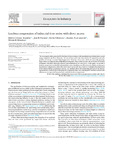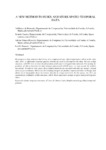Buscar
Mostrando ítems 1-10 de 13
GraCT: A Grammar Based Compressed Representation of Trajectories
(Springer, 2016-09-21)
[Abstract] We present a compressed data structure to store free trajectories of moving objects (ships over the sea, for example) allowing spatio-temporal queries. Our method, GraCT, uses a k2k2 -tree to store the absolute ...
GraCT: A Grammar-based Compressed Index for Trajectory Data
(Elsevier Ltd, 2019)
[Abstract]: We introduce a compressed data structure for the storage of free trajectories of moving objects that efficiently supports various spatio-temporal queries. Our structure, dubbed GraCT, stores the absolute positions ...
Efficient Processing of Raster and Vector Data
(Public Library of Science, 2020-01-10)
[Abstract] In this work, we propose a framework to store and manage spatial data, which includes new efficient algorithms to perform operations accepting as input a raster dataset and a vector dataset. More concretely, we ...
Compact and indexed representation for LiDAR point clouds
(Taylor & Francis, 2022)
[Abstract]: LiDAR devices are capable of acquiring clouds of 3D points reflecting any object around them, and adding additional attributes to each point such as color, position, time, etc. LiDAR datasets are usually large, ...
Space-Efficient Representations of Raster Time Series
(Elsevier, 2021)
[Abstract] Raster time series, a.k.a. temporal rasters, are collections of rasters covering the same region at consecutive timestamps. These data have been used in many different applications ranging from weather forecast ...
Map algebra on raster datasets represented by compact data structures
(John Wiley and Sons, 2023-06)
[Abstract]: The increase in the size of data repositories has forced the design of new computing paradigms to be able to process large volumes of data in a reasonable amount of time. One of them is in-memory computing, ...
An index for moving objects with constant-time access to their compressed trajectories
(Taylor & Francis, 2021)
[Abstract]: As the number of vehicles and devices equipped with GPS technology has grown explosively, an urgent need has arisen for time- and space-efficient data structures to represent their trajectories. The most commonly ...
3DGraCT: A Grammar-Based Compressed Representation of 3D Trajectories
(Springer, 2018)
[Abstract]: Much research has been published about trajectory management on the ground or at the sea, but compression or indexing of flight trajectories have usually been less explored. However, air traffic management is ...
Lossless Compression of Industrial Time Series With Direct Access
(Elsevier, 2021)
[Abstract] The new opportunities generated by the data-driven economy in the manufacturing industry have causedmany companies opt for it. However, the size of time series data that need to be captured creates theproblem ...
A New Method to Index and Store Spatio-Temporal Data
(2016-11-16)
[Abstract] We propose a data structure that stores, in a compressed way, object trajectories, which at the same time, allow to efficiently response queries without the need to decompress the data. We use a data structure, ...




